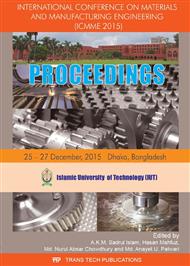[1]
H. Wu, Y. Zhao, M. H. White, Quantum mechanical modeling of MOSFET gate leakage for high-k gate dielectrics, Solid-State Electronics 50 (2006) 1164–1169.
DOI: 10.1016/j.sse.2006.04.036
Google Scholar
[2]
N. P. Maity, R. Maity, R. K. Thapa, S. Baishya, Effect of Image Force on Tunneling Current for Ultra Thin Oxide Layer Based Metal Oxide Semiconductor Devices, Nanoscience and Nanotechnology Letters 7 (2015) 331-333.
DOI: 10.1166/nnl.2015.1970
Google Scholar
[3]
F. Li, S. Mudanai, Y Fan, L. Franklin, S. Banerjee, Physically based Quantum Mechanical Compact Model of MOS Devices Substrate-Injected Tunneling Current Through Ultra Thin (EOT ~ 1 nm) SiO2 and High-K Gate Stacks, IEEE Trans. on Electron Devices 53 (2006).
DOI: 10.1109/ted.2006.871877
Google Scholar
[4]
N. P. Maity, R. Maity, R. K. Thapa, S. Baishya, Image Force Effect on Tunneling Current for Ultra Thin High-K Dielectric Material Al2O3 Based MOS Devices, Journal of Nanoelectronics and Optoelectronics 10 (2015) 645-648.
DOI: 10.1166/jno.2015.1812
Google Scholar
[5]
N. P. Maity, R. Maity, R. K. Thapa, S. Baishya, Study of Interface Charge Densities for ZrO2 and HfO2 based Metal-Oxide-Semiconductor Devices, Advances in Material Science and Engineering 2014 (2014) Article ID 497274 1-6.
DOI: 10.1155/2014/497274
Google Scholar
[6]
N. P. Maity, R. R. Thakur, R. Maity, R. K. Thapa, S. Baishya, Analysis of Interface Charge Using Capacitance-Voltage Method for Ultra Thin HfO2 Gate Dielectric based MOS Devices, Procedia Computer Science, 5 (2015) 757-760.
DOI: 10.1016/j.procs.2015.07.470
Google Scholar
[7]
N. P. Maity, R. R. Thakur, R. Maity, R. K. Thapa, S. Baishya, Interface Charge Density Measurement for Ultra Thin ZrO2 Material based MOS Devices Using Conductance Method, Procedia Computer Science, 5 (2015) 761-765.
DOI: 10.1016/j.procs.2015.07.472
Google Scholar
[8]
N. P. Maity, R. K. Thapa, S. Baishya, Comparison of Different High-k Dielectric Materials in MOS Device from C-V Characteristics, Advanced Materials Research 816 (2013) 60-64.
DOI: 10.4028/www.scientific.net/amr.816-817.60
Google Scholar
[9]
N. P. Maity, S. Chakraborty, M. Roy, Silicon and Silicon Carbide Based Metal-Oxide-Semiconductor Devices Using HfO2 and SiO2 Gate Dielectric, International Journal of Applied Engineering Research 6 (2011) 391-399.
Google Scholar
[10]
N. P. Maity, A. Kumar, R. Maity, S. Baishya, Analysis of Flatband Voltage of MOS Devices Using High-k Dielectric Materials, Procedia Material Science 5 (2014) 1198-1204.
DOI: 10.1016/j.mspro.2014.07.421
Google Scholar
[11]
N. P. Maity, A. Pandey, S. Chakraborty, M. Roy, High-k HfO2 based Metal-Oxide-Semiconductor Devices Using Silicon and Silicon Carbide Semiconductor, J. Nano - Electron. Phys. 3 (2011) 947-955.
Google Scholar
[12]
J. G. Simmons, Generalized Formula for the Electric Tunnel effect Between Similar Electrodes Separated by a Thin Insulating Film, Journal of Applied Physics, 34 (1963) 1793-1803.
DOI: 10.1063/1.1702682
Google Scholar


